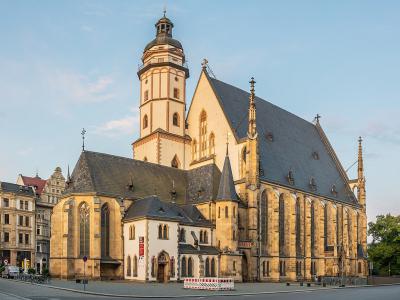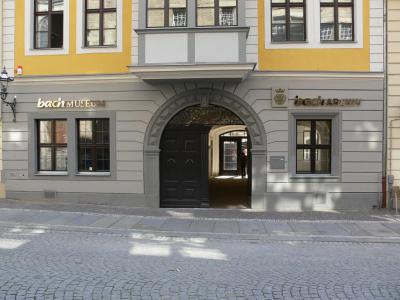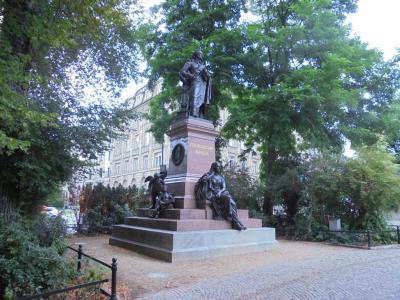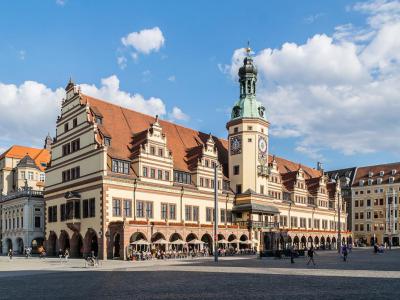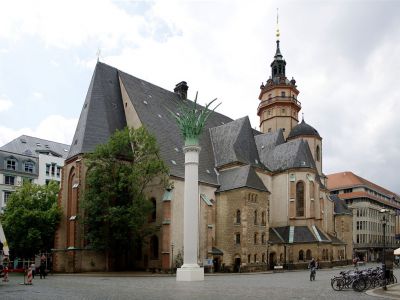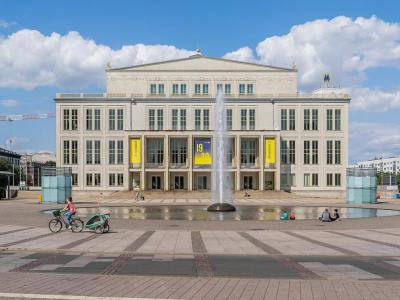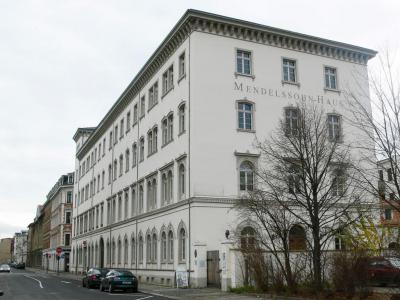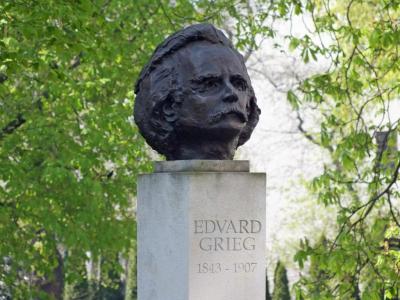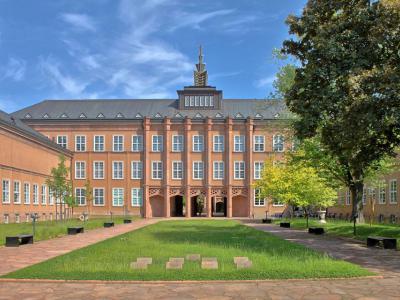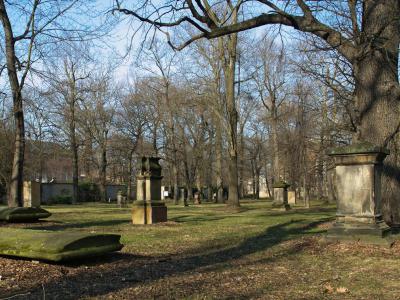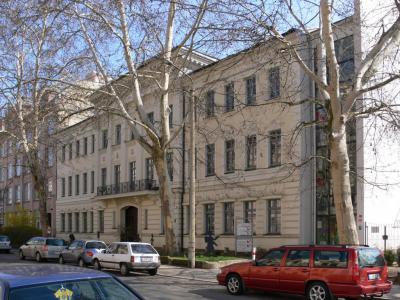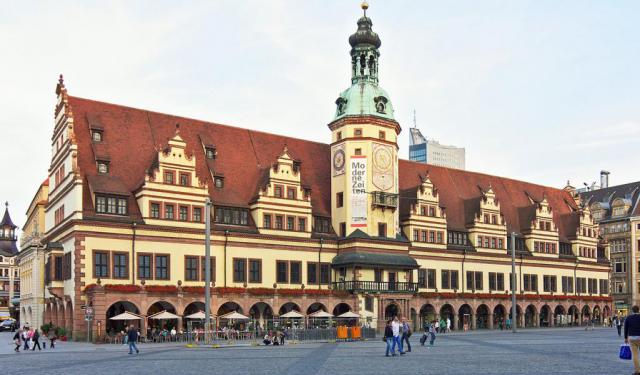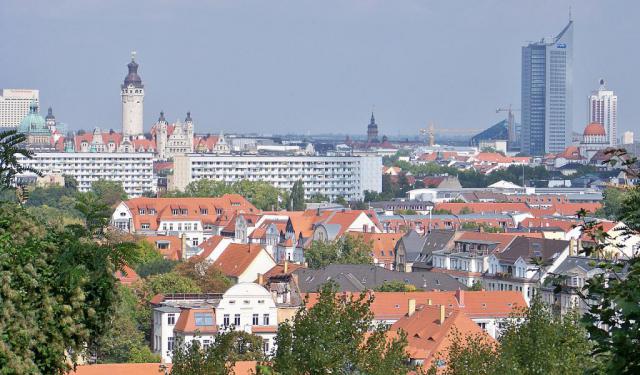A Walk on the Leipzig Music Trail (Self Guided), Leipzig
The spatial density of historic locations associated with music in Leipzig is truly mind-boggling. But then again, this is hardly surprising, given the eclectic score of musicians who had left their mark on the city in various years.
Indeed, it was in Leipzig that Johann Sebastian Bach served as an organist and choirmaster at Thomaskirche as well as a cantor at Nikolaikirche; composer Robert Schumann fell in love with and married pianist Clara Wieck; and Felix Mendelssohn Bartholdy worked as a director of the Gewandhaus orchestra, the oldest concert orchestra in the world, and then founded a conservatory to instruct his musical protegees.
The city was also home to Richard Wagner, Albert Lortzing, and Gustav Mahler, to mention but a few. Many of the former residences and places of work of these and other prominent musicians, now carefully-preserved, serve as museums. Among them are the Bach Museum, the Mendelssohn Haus, the Edvard Grieg Memorial, the Robert Schumann House and more. Some of the musical grands, like Bach, also found their final resting place here.
Add to this the Altes Rathaus (Old City Hall) where Bach signed an employment contract with the city, the Leipzig Opera House established since the 17th century, and the Museum of Musical Instruments boasting the largest collection of musical instruments in Germany (more than 10,000 pieces), and you, perhaps, will get an idea of the place that music holds in the heart of Leipzig.
The Leipzig Music Trail is fairly short and can be easily explored on foot, allowing visitors a unique chance to discover Leipzig's 800 years of music history on a leisurely stroll. If you wish to learn about the city's architecture, public spaces, history, and personalities – all in the context of musical tradition – take this self-guided walking tour.
Indeed, it was in Leipzig that Johann Sebastian Bach served as an organist and choirmaster at Thomaskirche as well as a cantor at Nikolaikirche; composer Robert Schumann fell in love with and married pianist Clara Wieck; and Felix Mendelssohn Bartholdy worked as a director of the Gewandhaus orchestra, the oldest concert orchestra in the world, and then founded a conservatory to instruct his musical protegees.
The city was also home to Richard Wagner, Albert Lortzing, and Gustav Mahler, to mention but a few. Many of the former residences and places of work of these and other prominent musicians, now carefully-preserved, serve as museums. Among them are the Bach Museum, the Mendelssohn Haus, the Edvard Grieg Memorial, the Robert Schumann House and more. Some of the musical grands, like Bach, also found their final resting place here.
Add to this the Altes Rathaus (Old City Hall) where Bach signed an employment contract with the city, the Leipzig Opera House established since the 17th century, and the Museum of Musical Instruments boasting the largest collection of musical instruments in Germany (more than 10,000 pieces), and you, perhaps, will get an idea of the place that music holds in the heart of Leipzig.
The Leipzig Music Trail is fairly short and can be easily explored on foot, allowing visitors a unique chance to discover Leipzig's 800 years of music history on a leisurely stroll. If you wish to learn about the city's architecture, public spaces, history, and personalities – all in the context of musical tradition – take this self-guided walking tour.
How it works: Download the app "GPSmyCity: Walks in 1K+ Cities" from Apple App Store or Google Play Store to your mobile phone or tablet. The app turns your mobile device into a personal tour guide and its built-in GPS navigation functions guide you from one tour stop to next. The app works offline, so no data plan is needed when traveling abroad.
A Walk on the Leipzig Music Trail Map
Guide Name: A Walk on the Leipzig Music Trail
Guide Location: Germany » Leipzig (See other walking tours in Leipzig)
Guide Type: Self-guided Walking Tour (Sightseeing)
# of Attractions: 11
Tour Duration: 2 Hour(s)
Travel Distance: 3.2 Km or 2 Miles
Author: karenl
Sight(s) Featured in This Guide:
Guide Location: Germany » Leipzig (See other walking tours in Leipzig)
Guide Type: Self-guided Walking Tour (Sightseeing)
# of Attractions: 11
Tour Duration: 2 Hour(s)
Travel Distance: 3.2 Km or 2 Miles
Author: karenl
Sight(s) Featured in This Guide:
- Thomaskirche (St. Thomas Church)
- Bach Museum
- Mendelssohn Monument
- Market Square and Old Town Hall
- Nikolaikirche (St. Nicholas Church)
- Leipzig Opera House
- Mendelssohn Haus (Mendelssohn House)
- Edvard Grieg Memorial and Social Centre
- Museum of Musical Instruments
- Alter Johannisfriedhof (Old St. John's Cemetery)
- Robert Schumann House
1) Thomaskirche (St. Thomas Church) (must see)
Since the 1100s, at least, there has been a church at the Saint Thomas Church site in Leipzig. Under the crossing and choir of the current Gothic hall church, there are the Romanesque foundations of a yet earlier church. In the 13th century, the earlier building became the Augustinian monastery and core of the University of Leipzig, founded in 1409.
Troubadour Heinrich von Morungen gifted a relic of Saint Thomas to the church in 1217. Martin Luther preached here in 1538. The current tower was built in 1537. Johann Sebastian Bach directed the choir at Saint Thomas and taught at Saint Thomas School until he died in 1750. Carl Seffner's statue of Bach next to the church was dedicated in 1906.
While on tour, Wolfgang Amadeus Mozart played the organ at the church in 1789. Richard Wagner was baptized here in 1813. He later studied piano with the cantor Christian Weinlig. A bronze statue of Felix Mendelssohn designed by sculptor Werner Stein was erected opposite the church in 1909.
Saint Thomas Church is 250 feet long with a nave of 164 feet. The roof is extraordinarily steep. The crown is 148 feet high, and the tower is 223 feet. At the end of the 19th century, the interior of the church was transformed from Baroque to Neo-Gothic.
The church is home to a variety of works of art. The baptismal font was made in 1615 by sculptor Franz Doteber. A Baroque crucifix by artist Caspar Freidrich Löbel remains from the times of Bach. The colored windows date from 1889. They show King Gustavus Adolphus of Sweden, Johann Sebastian Bach, Martin Luther, Elector Friedrich der Weise and Emperor Wilhelm I.
Saint Thomas Church has two pipe organs. The older, Romantic organ by Wilhelm Sauer was built in 1889. This organ was considered inadequate for Bach's music. The newest organ to replace the original was built in 2000. It was designed to look identical to the organ Bach played in the Saint Paul Church, where he was music director for holiday services in 1723−1725.
Troubadour Heinrich von Morungen gifted a relic of Saint Thomas to the church in 1217. Martin Luther preached here in 1538. The current tower was built in 1537. Johann Sebastian Bach directed the choir at Saint Thomas and taught at Saint Thomas School until he died in 1750. Carl Seffner's statue of Bach next to the church was dedicated in 1906.
While on tour, Wolfgang Amadeus Mozart played the organ at the church in 1789. Richard Wagner was baptized here in 1813. He later studied piano with the cantor Christian Weinlig. A bronze statue of Felix Mendelssohn designed by sculptor Werner Stein was erected opposite the church in 1909.
Saint Thomas Church is 250 feet long with a nave of 164 feet. The roof is extraordinarily steep. The crown is 148 feet high, and the tower is 223 feet. At the end of the 19th century, the interior of the church was transformed from Baroque to Neo-Gothic.
The church is home to a variety of works of art. The baptismal font was made in 1615 by sculptor Franz Doteber. A Baroque crucifix by artist Caspar Freidrich Löbel remains from the times of Bach. The colored windows date from 1889. They show King Gustavus Adolphus of Sweden, Johann Sebastian Bach, Martin Luther, Elector Friedrich der Weise and Emperor Wilhelm I.
Saint Thomas Church has two pipe organs. The older, Romantic organ by Wilhelm Sauer was built in 1889. This organ was considered inadequate for Bach's music. The newest organ to replace the original was built in 2000. It was designed to look identical to the organ Bach played in the Saint Paul Church, where he was music director for holiday services in 1723−1725.
2) Bach Museum
Housed in the historic Bose House, the Bach Archive and Museum in Leipzig features a permanent interactive multimedia exhibition dedicated to the life and work of Johann Sebastian Bach. The renowned 18th-century German composer, who made a name for himself internationally as the cantor of the nearby Saint Thomas's Church, used to live just across the street – in the old Saint Thomas’s School (now demolished).
The museum location is the former residence of the Bose family, affluent merchants and close friends of the Bachs. This is one of the oldest buildings in the area, dating back to 1711.
A true testament to modern museum culture, the venue contains numerous exhibits, spread across 12 rooms (750 square meters), allowing visitors to engage themselves in a variety of exciting things such as, for instance, a chance to compare modern-day Leipzig with its erstwhile version, to date Bach's works in a research lab, to explore the sound of Baroque-era instruments including an organ console at which Bach himself played in 1743, and even to arrange a Bach chorale to your own taste.
One of its highlights is the treasure room, featuring original Bach manuscripts and other precious items, such as a casket containing relics from Bach’s tomb, a recently discovered iron cash box that was once owned by the Bach family, and more.
The tunes floating from the organ pipes immerse visitors into the fascinating world of Bach's music and ensure by no means a passive experience. For additional enjoyment, there's a small pleasure garden, an audio studio and Café Gloria offering ample opportunity to sit back and relax after a busy time exploring the museum.
The museum location is the former residence of the Bose family, affluent merchants and close friends of the Bachs. This is one of the oldest buildings in the area, dating back to 1711.
A true testament to modern museum culture, the venue contains numerous exhibits, spread across 12 rooms (750 square meters), allowing visitors to engage themselves in a variety of exciting things such as, for instance, a chance to compare modern-day Leipzig with its erstwhile version, to date Bach's works in a research lab, to explore the sound of Baroque-era instruments including an organ console at which Bach himself played in 1743, and even to arrange a Bach chorale to your own taste.
One of its highlights is the treasure room, featuring original Bach manuscripts and other precious items, such as a casket containing relics from Bach’s tomb, a recently discovered iron cash box that was once owned by the Bach family, and more.
The tunes floating from the organ pipes immerse visitors into the fascinating world of Bach's music and ensure by no means a passive experience. For additional enjoyment, there's a small pleasure garden, an audio studio and Café Gloria offering ample opportunity to sit back and relax after a busy time exploring the museum.
3) Mendelssohn Monument
The Mendelssohn Monument in Leipzig is located in front of the western portal of Saint Thomas's Church, a spot often referred to as the Mendelssohn Portal due to the monument's presence. This monument honors Felix Mendelssohn Bartholdy, the renowned composer, former Leipzig Gewandhaus Kapellmeister, and founder of the local Conservatorium of Music. The current statue is a detailed replica of the original, which stood outside the second Gewandhaus, also known as the New Concert Hall (Neues Concerthaus), from 1892 until it was destroyed by the Nazis in 1936 due to Mendelssohn's Jewish heritage.
Erected in 2008, the 2.8-meter bronze statue stands on a stepped granite base. The upper part of the base is made from red Meissner granite, and the lower two steps are crafted from gray granite, making the total height of the monument 6.8 meters. Mendelssohn is depicted with a piano roll in his left hand and a baton in his right, standing in front of a music desk, reflecting his role as the first modern musical conductor.
At Mendelssohn's feet, the muse of music, Euterpe, sits on the steps, leaning on a lyre, accompanied by two pairs of angels: one pair singing and the other playing the flute and violin. The front of the pedestal bears Mendelssohn's name, while the back is inscribed with the phrase, "Nobleness can only be expressed through the language of music." The sides of the pedestal feature symbols of music: a bronze medallion with an organ on the left symbolizes sacred music, and on the right, masks, a vase with a dance scene, flutes, and a sword represent secular music.
The monument's location in the garden outside Saint Thomas's Church is particularly symbolic, as Mendelssohn conducted and played organ concerts there.
Erected in 2008, the 2.8-meter bronze statue stands on a stepped granite base. The upper part of the base is made from red Meissner granite, and the lower two steps are crafted from gray granite, making the total height of the monument 6.8 meters. Mendelssohn is depicted with a piano roll in his left hand and a baton in his right, standing in front of a music desk, reflecting his role as the first modern musical conductor.
At Mendelssohn's feet, the muse of music, Euterpe, sits on the steps, leaning on a lyre, accompanied by two pairs of angels: one pair singing and the other playing the flute and violin. The front of the pedestal bears Mendelssohn's name, while the back is inscribed with the phrase, "Nobleness can only be expressed through the language of music." The sides of the pedestal feature symbols of music: a bronze medallion with an organ on the left symbolizes sacred music, and on the right, masks, a vase with a dance scene, flutes, and a sword represent secular music.
The monument's location in the garden outside Saint Thomas's Church is particularly symbolic, as Mendelssohn conducted and played organ concerts there.
4) Market Square and Old Town Hall (must see)
The Market Square of Leipzig is the central place of Leigzip's city center. There are arcades and courtyards well worth a visit, and the Old Town Hall housing the City History Museum is the central attraction. Saint Nicholas and Saint Thomas Churches are easily reached from here.
Throughout the year, the square is the venue of a diversity of Markets and events. There is the Easter Market, the Wine Festival, Leipzig Market Music, and the fabulous Christmas Market. Since the 13th century, Leipzig and its Markets have been the most vital centers of trade in Germany.
In 1341, Frederick II, Son of Frederick the Peaceful and Margrave of Meissen, offered the cloth merchants of Leipzig a Romanesque building of their own at the south end of the Leipzig Market Square. This building, called the Cloth Hall (Tuchhaus), shared extensions and spaces with the City Council.
The building complex grew. Two structures were added in the 15th century. A council chamber was completed in 1467. A stair tower emerged in 1476. In 1498, after all the growth and extensions, it was decided to rebuild the Town Hall.
The Old Town Hall was rebuilt in its current Saxon Renaissance style in 1557. It housed the Upper Court and the Court of Aldermen, the city magistrate, council archives, and prison cells. In 1905, it was decided to use the Old Town Hall as the Leipzig City History Museum.
The two-story building is over 300 feet long. It has a steep roof with 13 connecting row dormers and staggered gables. A stone arcade faces the square. An octagonal stair tower is next to the main entrance. The entrance is flanked by two ionic columns topped with the gaff heads of the master builders. Stone box oriels are on the gable ends.
In the large ceremonial hall is a portrait of Johann Sebastian Bach by German painter Elias Gottlob Haussmann. Haussmann also signed Bach's employment certificate as a cantor at Saint Thomas' Church. There is also a scale model of the city in 1832 made by Leipzig upholsterer and furniture maker Johann Christoph Merzdorf.
Throughout the year, the square is the venue of a diversity of Markets and events. There is the Easter Market, the Wine Festival, Leipzig Market Music, and the fabulous Christmas Market. Since the 13th century, Leipzig and its Markets have been the most vital centers of trade in Germany.
In 1341, Frederick II, Son of Frederick the Peaceful and Margrave of Meissen, offered the cloth merchants of Leipzig a Romanesque building of their own at the south end of the Leipzig Market Square. This building, called the Cloth Hall (Tuchhaus), shared extensions and spaces with the City Council.
The building complex grew. Two structures were added in the 15th century. A council chamber was completed in 1467. A stair tower emerged in 1476. In 1498, after all the growth and extensions, it was decided to rebuild the Town Hall.
The Old Town Hall was rebuilt in its current Saxon Renaissance style in 1557. It housed the Upper Court and the Court of Aldermen, the city magistrate, council archives, and prison cells. In 1905, it was decided to use the Old Town Hall as the Leipzig City History Museum.
The two-story building is over 300 feet long. It has a steep roof with 13 connecting row dormers and staggered gables. A stone arcade faces the square. An octagonal stair tower is next to the main entrance. The entrance is flanked by two ionic columns topped with the gaff heads of the master builders. Stone box oriels are on the gable ends.
In the large ceremonial hall is a portrait of Johann Sebastian Bach by German painter Elias Gottlob Haussmann. Haussmann also signed Bach's employment certificate as a cantor at Saint Thomas' Church. There is also a scale model of the city in 1832 made by Leipzig upholsterer and furniture maker Johann Christoph Merzdorf.
5) Nikolaikirche (St. Nicholas Church) (must see)
One of the most important churches of Leipzig is named for Saint Nicholas, the patron saint of travelers and merchants. The church started in 1185 as a Romanesque-style edifice with two look-alike towers. It was enlarged and redone in the 16th century in the Gothic "hall church" style, which features a nave and aisles of approximately equal height, united under a single immense roof. The Baroque-style central tower was added in 1730.
The interior was remodeled in 1797, in a Neoclassical style, by architect Johann Carl Friedrich Dauthe. Inside, the apse is semicircular with a barrel vault roof. The narrow nave is supported by graceful Egyptian-style columns, with palm-shaped capitals. The interior colors are in two pastel shades of pale green and dusty rose.
The church hosted four of the five premier performances of Johann Sebastian Bach's Passion of Saint John in 1724, 1728, 1732, and 1749. Several of his cantatas and oratorios were performed by the Saint Thomas Choir of Leipzig (Thomanerchor), a boy's choir with a tradition of more than 800 years in music and city history.
From 1989 to 1991, people would gather at Saint Nicholas every Monday evening. The meetings were not formal. They led to ad hoc protests against the Communist East German Government. Cabaret artist Bernd-Lutz Lange declared of the revolution: "The head was the Saint Nicholas Church and the body the center of the city."
The authorities were thrown off balance, as they were expecting violence. But that never occurred, violance were not in the playbook. A monumental column stands outside the church today. Close to the Neoclassical column, colored panels in the pavement light up after dark, telling the story of the Monday night marchers.
The interior was remodeled in 1797, in a Neoclassical style, by architect Johann Carl Friedrich Dauthe. Inside, the apse is semicircular with a barrel vault roof. The narrow nave is supported by graceful Egyptian-style columns, with palm-shaped capitals. The interior colors are in two pastel shades of pale green and dusty rose.
The church hosted four of the five premier performances of Johann Sebastian Bach's Passion of Saint John in 1724, 1728, 1732, and 1749. Several of his cantatas and oratorios were performed by the Saint Thomas Choir of Leipzig (Thomanerchor), a boy's choir with a tradition of more than 800 years in music and city history.
From 1989 to 1991, people would gather at Saint Nicholas every Monday evening. The meetings were not formal. They led to ad hoc protests against the Communist East German Government. Cabaret artist Bernd-Lutz Lange declared of the revolution: "The head was the Saint Nicholas Church and the body the center of the city."
The authorities were thrown off balance, as they were expecting violence. But that never occurred, violance were not in the playbook. A monumental column stands outside the church today. Close to the Neoclassical column, colored panels in the pavement light up after dark, telling the story of the Monday night marchers.
6) Leipzig Opera House
Leipzig Opera House, located on Augustusplatz in Leipzig, is a historic institution with roots dating back to the late 17th century. Leipzig's operatic tradition began in 1693, making it the third oldest opera city in Europe, following Venice and Hamburg. The early performances were held at the Opera at Brühl (Oper am Brühl), where Georg Philipp Telemann, a renowned self-taught German Baroque composer, served as director from 1703 to 1705, contributing significantly to the city's musical landscape.
The first opera house on the current site, known as the New Theater (Neues Theater), was inaugurated in 1868. Notably, Gustav Mahler, a prominent Austro-Bohemian composer and conductor, served as the second conductor at the New Theater from 1886 to 1888. Mahler is recognized as a pivotal figure who bridged the 19th-century Austro-German musical tradition with the emerging modernism of the early 20th century.
Tragically, the New Theater, along with other theaters in Leipzig, was destroyed during an Allied air raid on December 3-4, 1943, during World War II. Post-war performances were temporarily moved to Dreilinden House, now known as the Musical Comedy (Musikalische Komödie). In 1950, the decision was made by the Council of Ministers of the GDR to demolish the remains of the New Theater and construct a new opera house on its site. After several competitions and deliberations, architects Kunz Nierade and Kurt Hemmerling were commissioned in 1954 to design the new building.
Construction of the modern Leipzig Opera House began in 1956, and the new theater opened its doors on October 8, 1960, with a performance of Richard Wagner's "Die Meistersinger von Nürnberg." At the time of its inauguration, the Oper Leipzig boasted some of the most advanced stage equipment in Europe. The opera house expanded its offerings in the 1970s with the addition of a basement theater for chamber productions, although this space is now closed. In 1990, a small art gallery was also integrated into the building, enhancing its cultural footprint in Leipzig.
The first opera house on the current site, known as the New Theater (Neues Theater), was inaugurated in 1868. Notably, Gustav Mahler, a prominent Austro-Bohemian composer and conductor, served as the second conductor at the New Theater from 1886 to 1888. Mahler is recognized as a pivotal figure who bridged the 19th-century Austro-German musical tradition with the emerging modernism of the early 20th century.
Tragically, the New Theater, along with other theaters in Leipzig, was destroyed during an Allied air raid on December 3-4, 1943, during World War II. Post-war performances were temporarily moved to Dreilinden House, now known as the Musical Comedy (Musikalische Komödie). In 1950, the decision was made by the Council of Ministers of the GDR to demolish the remains of the New Theater and construct a new opera house on its site. After several competitions and deliberations, architects Kunz Nierade and Kurt Hemmerling were commissioned in 1954 to design the new building.
Construction of the modern Leipzig Opera House began in 1956, and the new theater opened its doors on October 8, 1960, with a performance of Richard Wagner's "Die Meistersinger von Nürnberg." At the time of its inauguration, the Oper Leipzig boasted some of the most advanced stage equipment in Europe. The opera house expanded its offerings in the 1970s with the addition of a basement theater for chamber productions, although this space is now closed. In 1990, a small art gallery was also integrated into the building, enhancing its cultural footprint in Leipzig.
7) Mendelssohn Haus (Mendelssohn House)
The Mendelssohn House in Leipzig is a museum dedicated to the life and work of composer Felix Mendelssohn, who lived there from 1845 until he died in 1847. Originally from Hamburg, Mendelssohn moved to Leipzig in 1835 when he became the director of the Gewandhaus Orchestra. His family joined him in 1845, settling in an apartment on the bel etage (second floor) of this building. This house witnessed both personal and professional milestones for Mendelssohn, including the birth of his daughter Elisabeth, and it was also the place where he passed away on November 4, 1847.
In 1991, the International Mendelssohn Foundation was established to preserve Mendelssohn's last home in Leipzig, and by 1997, the museum was opened to the public. The property has been meticulously restored to reflect its appearance during Mendelssohn's lifetime, complete with furnishings in the late Biedermeier style. Visitors can explore Mendelssohn’s former apartment, which showcases original furniture, personal documents, musical sheets with autographs, first prints of his works, and some of his watercolors. A highlight of the museum is the composer’s study, which preserves the ambiance in which he created pieces like the oratorio "Elias."
The museum also features a music salon used for matinee concerts every Sunday and a large chamber music hall located on the first floor of the former coach house. In 2014, the museum expanded to include an interactive installation on the ground floor, where visitors can virtually conduct an orchestra, arrange instruments, and switch between modern and historical versions during playback. Additionally, the garden house within the historical garden now hosts a "world for children," further enriching the museum's offerings.
Recognized for its cultural significance, the Mendelssohn House is listed in the Blaubuch (Blue Book) of the German Federal Government as an important cultural site, continuing to celebrate the legacy of Felix Mendelssohn in Leipzig.
In 1991, the International Mendelssohn Foundation was established to preserve Mendelssohn's last home in Leipzig, and by 1997, the museum was opened to the public. The property has been meticulously restored to reflect its appearance during Mendelssohn's lifetime, complete with furnishings in the late Biedermeier style. Visitors can explore Mendelssohn’s former apartment, which showcases original furniture, personal documents, musical sheets with autographs, first prints of his works, and some of his watercolors. A highlight of the museum is the composer’s study, which preserves the ambiance in which he created pieces like the oratorio "Elias."
The museum also features a music salon used for matinee concerts every Sunday and a large chamber music hall located on the first floor of the former coach house. In 2014, the museum expanded to include an interactive installation on the ground floor, where visitors can virtually conduct an orchestra, arrange instruments, and switch between modern and historical versions during playback. Additionally, the garden house within the historical garden now hosts a "world for children," further enriching the museum's offerings.
Recognized for its cultural significance, the Mendelssohn House is listed in the Blaubuch (Blue Book) of the German Federal Government as an important cultural site, continuing to celebrate the legacy of Felix Mendelssohn in Leipzig.
8) Edvard Grieg Memorial and Social Centre
The Norwegian composer Edvard Grieg got his formal musical education in Leipzig. He arrived in the city, for the first time, in September 1858, aged fifteen.
The musical life in Leipzig of that period was vibrant and exciting: the Gewandhaus orchestra was a magnet for Europe’s best virtuosi as a chance to play new stuff. Opera was another source of inspiration and the young Grieg, surely inspired, attended every performance of Wagner’s Tannhȁuser during his first year in Leipzig. There and then he also heard Clara Schumann play her husband’s piano concerto, and met Tchaikovsky and Brahms.
Grieg completed his studies in 1862. Afterwards, he kept in touch with his publisher, Carl Friedrich Peters, at Talstrasse 10, and visited Leipzig several times as a guest of publishers M. Abraham and H. Hinrichsen. On each of those occasions, the flat ‘above the shop’ in the C.F. Peters building was made available to him. It was also here that he composed Peer Gynt Suite n1, in 1888.
After many years of disrepair, this property has finally undergone extensive restoration, courtesy of the memorial and social center which documents the life of Edvard Grieg, and today boasts a permanent extensive exhibition. Here, apart from learning about the life and work of Grieg in Leipzig, visitors can attend concerts in the same room where the Norwegian composer himself once played excerpts from his new compositions to a limited audience.
The musical life in Leipzig of that period was vibrant and exciting: the Gewandhaus orchestra was a magnet for Europe’s best virtuosi as a chance to play new stuff. Opera was another source of inspiration and the young Grieg, surely inspired, attended every performance of Wagner’s Tannhȁuser during his first year in Leipzig. There and then he also heard Clara Schumann play her husband’s piano concerto, and met Tchaikovsky and Brahms.
Grieg completed his studies in 1862. Afterwards, he kept in touch with his publisher, Carl Friedrich Peters, at Talstrasse 10, and visited Leipzig several times as a guest of publishers M. Abraham and H. Hinrichsen. On each of those occasions, the flat ‘above the shop’ in the C.F. Peters building was made available to him. It was also here that he composed Peer Gynt Suite n1, in 1888.
After many years of disrepair, this property has finally undergone extensive restoration, courtesy of the memorial and social center which documents the life of Edvard Grieg, and today boasts a permanent extensive exhibition. Here, apart from learning about the life and work of Grieg in Leipzig, visitors can attend concerts in the same room where the Norwegian composer himself once played excerpts from his new compositions to a limited audience.
9) Museum of Musical Instruments
The Museum of Musical Instruments of the University of Leipzig is a prominent part of the Grassi Museum complex, which also houses the Museum of Ethnography and the Museum of Applied Arts. Renowned as one of the largest musical instrument museums in Europe, it boasts a collection of nearly 10,000 items, including instruments and related artifacts from Europe and beyond, with pieces dating back to the Renaissance, Baroque, and the period of Bach's Leipzig.
The museum's origins trace back to 1886 when Dutchman Paul de Wit established a museum dedicated to historic musical instruments in Leipzig. In 1905, he sold the collection to Wilhelm Heyer, a paper merchant, who expanded it further. By 1926, the University of Leipzig acquired the entire Heyer collection with financial support from the State of Saxony and the music publisher Carl Friedrich Peters. The collection found a permanent home in the New Grassi Museum, officially opening its doors in 1929.
However, the museum's journey was not without setbacks. During World War II, despite efforts to protect the collection, a significant number of items were destroyed in a bombing raid in 1943 or were damaged and lost due to inadequate storage and theft.
In the 1950s, the museum began a slow process of rebuilding and eventually reopened to the public. Over the decades, the collection was replenished through acquisitions and donations, ensuring the preservation of its most valuable pieces, including instruments from the De Wit, Heyer, Kraus, Friedrich von Amerling, and Ibach collections.
Today, the museum's exhibits are organized chronologically into 13 sections, showcasing categories such as bowed, wind, and percussion instruments, with the oldest dating from the 16th century. It also features a sound laboratory where visitors can interact with and test out musical instruments, offering a dynamic experience that brings the history of music to life.
The museum's origins trace back to 1886 when Dutchman Paul de Wit established a museum dedicated to historic musical instruments in Leipzig. In 1905, he sold the collection to Wilhelm Heyer, a paper merchant, who expanded it further. By 1926, the University of Leipzig acquired the entire Heyer collection with financial support from the State of Saxony and the music publisher Carl Friedrich Peters. The collection found a permanent home in the New Grassi Museum, officially opening its doors in 1929.
However, the museum's journey was not without setbacks. During World War II, despite efforts to protect the collection, a significant number of items were destroyed in a bombing raid in 1943 or were damaged and lost due to inadequate storage and theft.
In the 1950s, the museum began a slow process of rebuilding and eventually reopened to the public. Over the decades, the collection was replenished through acquisitions and donations, ensuring the preservation of its most valuable pieces, including instruments from the De Wit, Heyer, Kraus, Friedrich von Amerling, and Ibach collections.
Today, the museum's exhibits are organized chronologically into 13 sections, showcasing categories such as bowed, wind, and percussion instruments, with the oldest dating from the 16th century. It also features a sound laboratory where visitors can interact with and test out musical instruments, offering a dynamic experience that brings the history of music to life.
10) Alter Johannisfriedhof (Old St. John's Cemetery)
Old Saint John's Cemetery in Leipzig is the city's oldest burial ground, with roots tracing back to 1278. Initially established as part of Saint John's Hospital for lepers, it later became attached to Saint John's Church, built in the 14th century but destroyed during World War II. In 1536, under the directive of George, Duke of Saxony, the cemetery transitioned into a common graveyard, undergoing several expansions over the centuries in 1680, 1805, and finally from 1827 to 1863. It was also redesigned in the style of the Camposanto Monumentale in Pisa, blending its historic legacy with a touch of Italian monumental cemetery architecture.
This cemetery served as the final resting place for many of Leipzig's prominent figures, including musicians, composers, and music publishers. A notable discovery occurred in 1894 during the reconstruction of the Johanniskirche nave when the remains of Johann Sebastian Bach, who had been buried there in 1750, were unearthed. His remains, along with those of Christian Fürchtegott Gellert, a celebrated German poet, were reinterred beneath the church altar in 1900. Despite the church's destruction in 1943 due to Allied bombing, the coffins of Bach and Gellert were miraculously preserved. Bach's remains were subsequently moved to the Thomaskirche in 1949, while Gellert's were relocated to the Paulinerkirche.
By the early 20th century, Old Saint John's Cemetery had evolved into a memorial park. It was temporarily closed in 1981 and underwent a comprehensive clearance. After extensive renovations, it reopened in 1995 and remains a protected monument, reflecting Leipzig’s rich historical and cultural heritage.
This cemetery served as the final resting place for many of Leipzig's prominent figures, including musicians, composers, and music publishers. A notable discovery occurred in 1894 during the reconstruction of the Johanniskirche nave when the remains of Johann Sebastian Bach, who had been buried there in 1750, were unearthed. His remains, along with those of Christian Fürchtegott Gellert, a celebrated German poet, were reinterred beneath the church altar in 1900. Despite the church's destruction in 1943 due to Allied bombing, the coffins of Bach and Gellert were miraculously preserved. Bach's remains were subsequently moved to the Thomaskirche in 1949, while Gellert's were relocated to the Paulinerkirche.
By the early 20th century, Old Saint John's Cemetery had evolved into a memorial park. It was temporarily closed in 1981 and underwent a comprehensive clearance. After extensive renovations, it reopened in 1995 and remains a protected monument, reflecting Leipzig’s rich historical and cultural heritage.
11) Robert Schumann House
The Robert Schumann House in Leipzig is a historical site that once served as the home of the renowned German composer Robert Schumann and his wife, the celebrated pianist Clara Schumann. The couple resided here for the first four years of their marriage, from 1840 to 1844. Built in 1838 by Friedrich August Scheidel, the house is a strictly symmetrical Neoclassical building with three stories; the Schumanns occupied the first-floor apartment.
Their home quickly became a vibrant cultural hub, attracting prominent guests such as Felix Mendelssohn Bartholdy, Franz Liszt, Richard Wagner, Hector Berlioz, and Hans Christian Andersen. During their time here, Robert Schumann composed some of his significant works, including the Spring Symphony, the three String Quartets, and the Piano Quintet.
Although the house survived World War II with minimal damage, it fell into disrepair during the 1970s, despite being recognized as a historical monument in the GDR. In 1999, the Rahn Dittrich Group acquired and renovated the building, aided by the Robert and Clara Schumann Association, established in 1995. Today, the Schumann Museum is housed within the former apartment and includes various themed rooms: the Schumann Salon, where the couple entertained guests; the Travel Room, dedicated to their concert tours in Denmark and Russia; and the Sound Room (Klangraum), designed in the Biedermeier style and featuring an interactive sound installation by artist Erwin Stache.
Beyond the museum, the building also accommodates a small concert hall and the Clara Schumann primary school, which has an artistic and musical focus. The concert hall hosts regular musical performances, readings, and discussions, and the venue is part of the UNESCO Leipzig Music Trail. In 2019, to commemorate Clara Schumann's 200th anniversary, the Schumann House unveiled a renewed and expanded permanent exhibition, enhancing its role as a center for musical heritage and cultural engagement in Leipzig.
Their home quickly became a vibrant cultural hub, attracting prominent guests such as Felix Mendelssohn Bartholdy, Franz Liszt, Richard Wagner, Hector Berlioz, and Hans Christian Andersen. During their time here, Robert Schumann composed some of his significant works, including the Spring Symphony, the three String Quartets, and the Piano Quintet.
Although the house survived World War II with minimal damage, it fell into disrepair during the 1970s, despite being recognized as a historical monument in the GDR. In 1999, the Rahn Dittrich Group acquired and renovated the building, aided by the Robert and Clara Schumann Association, established in 1995. Today, the Schumann Museum is housed within the former apartment and includes various themed rooms: the Schumann Salon, where the couple entertained guests; the Travel Room, dedicated to their concert tours in Denmark and Russia; and the Sound Room (Klangraum), designed in the Biedermeier style and featuring an interactive sound installation by artist Erwin Stache.
Beyond the museum, the building also accommodates a small concert hall and the Clara Schumann primary school, which has an artistic and musical focus. The concert hall hosts regular musical performances, readings, and discussions, and the venue is part of the UNESCO Leipzig Music Trail. In 2019, to commemorate Clara Schumann's 200th anniversary, the Schumann House unveiled a renewed and expanded permanent exhibition, enhancing its role as a center for musical heritage and cultural engagement in Leipzig.
Walking Tours in Leipzig, Germany
Create Your Own Walk in Leipzig
Creating your own self-guided walk in Leipzig is easy and fun. Choose the city attractions that you want to see and a walk route map will be created just for you. You can even set your hotel as the start point of the walk.
Leipzig Architectural Jewels
Anyone who has ever wanted to delve into Leipzig's history could hardly imagine doing so without exploring the local array of architectural jewels. Indeed, Leipzig boasts one of Germany's most beautiful collections of Renaissance buildings.
Our first point of interest lies in downtown Leipzig at the intersection of Katherine and Bruhl Streets. Here, the stunning Baroque-style Romanus... view more
Tour Duration: 1 Hour(s)
Travel Distance: 0.9 Km or 0.6 Miles
Our first point of interest lies in downtown Leipzig at the intersection of Katherine and Bruhl Streets. Here, the stunning Baroque-style Romanus... view more
Tour Duration: 1 Hour(s)
Travel Distance: 0.9 Km or 0.6 Miles
Leipzig Introduction Walking Tour
The name "Leipzig" may be derived from the Slavic word "Lipsk", meaning "linden trees place." The Nazi government renamed the city "Reichsmessestadt Leipzig" ("Reich Fair Trade City Leipzig"). In 1989, with the fall of communism, the city was "Hero City" - in recognition of the role that the Monday demonstrations there played in the fall... view more
Tour Duration: 1 Hour(s)
Travel Distance: 2.4 Km or 1.5 Miles
Tour Duration: 1 Hour(s)
Travel Distance: 2.4 Km or 1.5 Miles
The Most Popular Cities
/ view all



